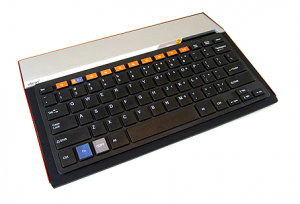The perfect computer for anyone who likes Airfix models. Or Ikea furniture.
A name not many people in the RISC OS world will have heard of until very recently is Ident Computer, run by Shrewsbury-based Tom Williamson. Tom founded his company, the Ident Broadcasting & Communications Group, in 2006, and Ident Computer is a comparatively recent addition to the group, with the aim of preserving and exhibiting retro computers, and to aid and build new resources for education and entertainment.
One of the outcomes of that goal is a new Raspberry Pi-based computer called the Micro One.

The Micro One has been in development for a while, and you may have seen an earlier version at recent RISC OS events such as Wakefield 2016. Tom hasn’t himself attended any of our main shows as yet, but Tony Bartram of AMCOG Games has been using a Micro One on his stand, and happily telling visitors who enquired what it is and where it came from.
More recently, Tom attended the Midlands User Group‘s May meeting, where he gave a presentation that started with his background, leading up to the development of the computer – and more recently still, he attended the Recursion Computer Science Fair as part of the RISC OS contingent, bringing the finished Micro One Mk4 with him1. Visitors to this year’s London Show will also get to speak to Tom and see the computer in action, as he will be in attendance at that event, which takes place on 29th October, 2016.

The Micro One is a kit-form computer (i.e. you build it yourself from the supplied parts) which is designed to house a Raspberry Pi – either the A+, B+, or the version 2 or 3, with the original models A and B unsupported. This is because the original versions lacked holes to screw a Pi into place, which is necessary for this system.
Coming in a choice of three trim colours – red, green and blue – the case itself is put together with a steady hand and some glue, with some abrasive paper also a good idea. A “quality super glue” is recommended, and the abrasive paper can be used to lightly sand the areas to be glued in order to aid adhesion.

If you are aren’t comfortable putting things together, it can also be purchased part-assembled, with only a small amount of work left to do, and whichever version you buy it comes with a fully licensed copy of RISC OS on a micro-SD card, a USB mouse, a three-way USB hub and a CAT5e extension cable/port.
One of the nice things about the Micro One is that it leaves you with a modern computer in a form factor reminiscent of 8-bit ‘retro’ platforms – its size and shape is similar to an Acorn Electron2. The Raspberry Pi itself is screwed into place at the back right of the case, sideways on, an alignment that means the micro-USB port used for power – which is on the right of the Pi on every version of the board since the B+ – is exposed at the rear of the computer.

The USB ports on the Pi, along with the ethernet socket, are all internal as a result of that alignment – which is the purpose of the USB hub and Cat5e extension. These connect internally to the Pi and are used to bring the necessary sockets to the rear of the Micro One. Finally, access to the GPIO pins is provided at the top right of the case, immediately above the keyboard.
£165 will get you the Micro One as a kit, and £190 partially assembled – which in either case is a pretty good price, and presents a good way to get started with a Raspberry Pi and RISC OS.
!ReadMe
- Purchasing at Recursion was on an order basis, with the Micro One available to collect at the show to those who had ordered one in advance of the show. It seems likely that the London Show will the see the same approach – so keep your eyes out for announcements in the run up to the event.
- The Acorn Electron was 340mm wide, 160mm deep and 65mm high, while the Micro One is 350mm wide, 186mm deep, and 37mm high – with these measurements being approximate because while there is one in the RISCOSitory/Soft Rock Software bunker, it is yet to be assembled.



